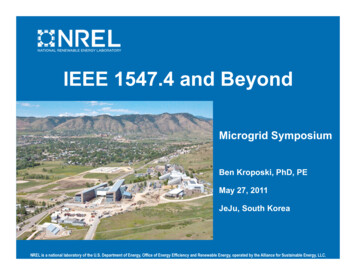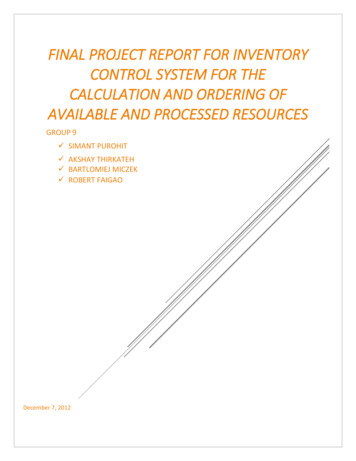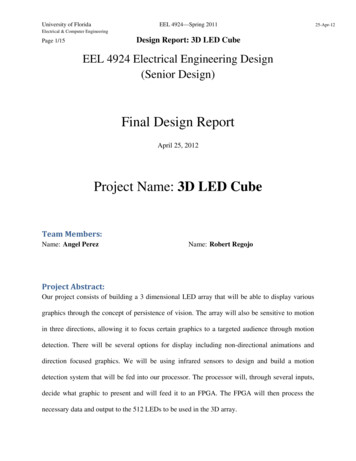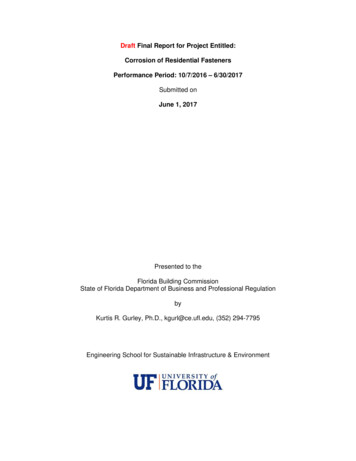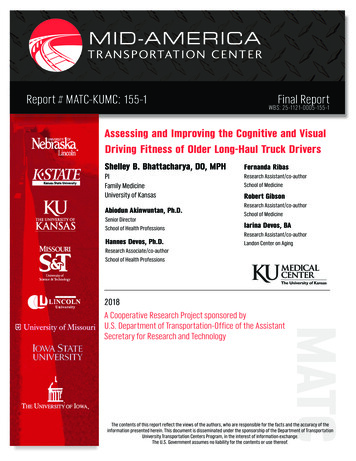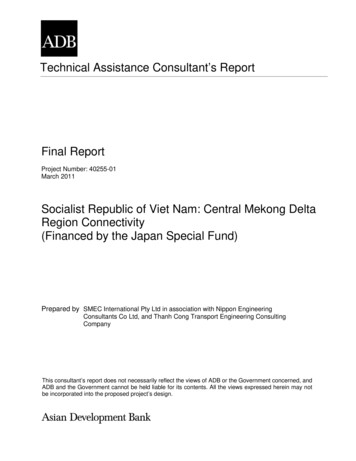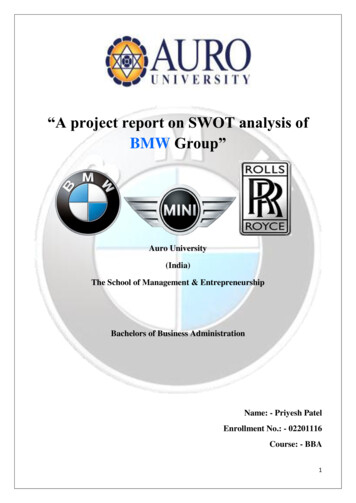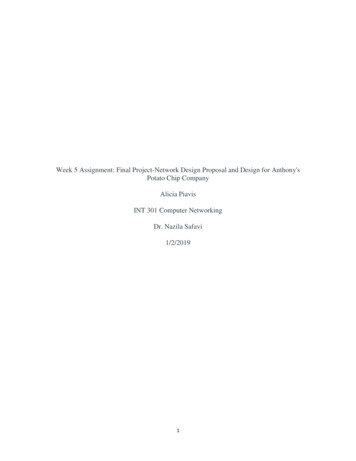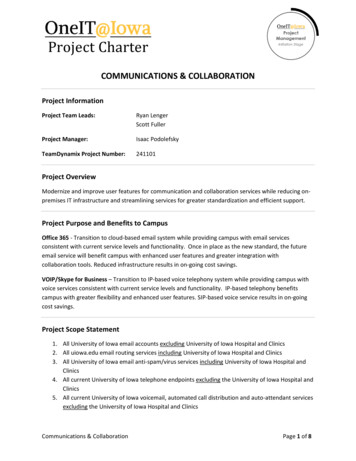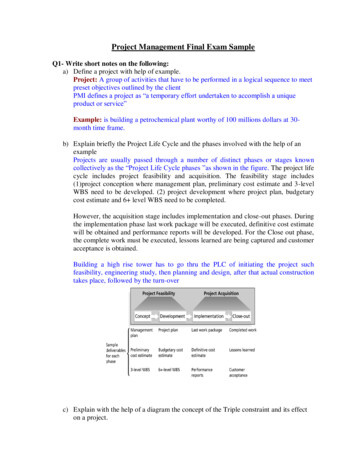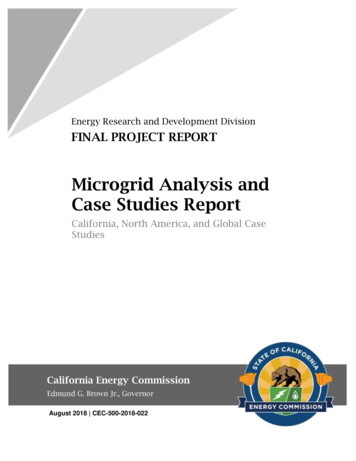
Transcription
Energy Research and Development DivisionFINAL PROJECT REPORTMicrogrid Analysis andCase Studies ReportCalifornia, North America, and Global CaseStudiesCalifornia Energy CommissionEdmund G. Brown Jr., GovernorAugust 2018 CEC-500-2018-022Month Year CEC-XXX-XXXX-XXX
PREPARED BY:Primary Author(s):Peter AsmusAdam ForniLaura VogelNavigant Consulting, Inc.1 Market Street, Spear TowerSuite 1200San Francisco, CA 94105Phone: 415-356-7100 Fax: 415-356-4005navigant.comContract Number: NAV-15-001Navigant Consulting, Inc. Master Agreement 300-15-009PREPARED FOR:California Energy CommissionMike GravelyProject ManagerFernando PinaOffice ManagerENERGY SYSTEMS RESEARCH OFFICELaurie ten HopeDeputy DirectorENERGY RESEARCH AND DEVELOPMENT DIVISIONDrew BohanExecutive DirectorDISCLAIMERThis report was prepared as the result of work sponsored by the California Energy Commission. It does notnecessarily represent the views of the Energy Commission, its employees, or the State of California. The EnergyCommission, the State of California, its employees, contractors, and subcontractors make no warranty, express orimplied, and assume no legal liability for the information in this report; nor does any party represent that the usesof this information will not infringe upon privately owned rights. This report has not been approved ordisapproved by the California Energy Commission, nor has the California Energy Commission passed upon theaccuracy or adequacy of the information in this report.
PREFACEThe California Energy Commission’s Energy Research and Development Division supportsenergy research and development programs to spur innovation in energy efficiency, renewableenergy and advanced clean generation, energy-related environmental protection, energytransmission and distribution and transportation.In 2012, the Electric Program Investment Charge (EPIC) was established by the California PublicUtilities Commission to fund public investments in research to create and advance new energysolution, foster regional innovation and bring ideas from the lab to the marketplace. TheCalifornia Energy Commission and the state’s three largest investor-owned utilities – Pacific Gasand Electric Company, San Diego Gas & Electric Company and Southern California EdisonCompany – were selected to administer the EPIC funds and advance novel technologies, tools,and strategies that provide benefits to their electric ratepayers.The Energy Commission is committed to ensuring public participation in its research anddevelopment programs that promote greater reliability, lower costs, and increase safety for theCalifornia electric ratepayer and include: Providing societal benefits. Reducing greenhouse gas emission in the electricity sector at the lowest possible cost. Supporting California’s loading order to meet energy needs first with energy efficiencyand demand response, next with renewable energy (distributed generation and utilityscale), and finally with clean, conventional electricity supply. Supporting low-emission vehicles and transportation. Providing economic development. Using ratepayer funds efficiently.Microgrid Analysis and Case Studies Report is the final report for the Microgrid Support project(Contract Number 300-15-009, Work Authorization Number NAV-15-001) conducted byNavigant Consulting Inc. The information from this project contributes to Energy Research andDevelopment Division’s EPIC Program.For more information about the Energy Research and Development Division, please visit theEnergy Commission’s website at www.energy.ca.gov/research/ or contact the EnergyCommission at 916-327-1551.i
ABSTRACTThe Energy Commission seeks to understand the technologies, business models, scale, andvendor landscape supporting microgrids that are commercially viable in the absence ofgovernment grants and funding. This report features 26 microgrid case studies from California,North America, and other countries that make innovative business cases and rely ongovernment support for less than 50 percent of project costs. The microgrids profiled range insize from 78 kW (a small demonstration in Michigan) to 112.5 MW (Denmark), and servecommercial, military, municipal, education, agriculture, and utility clients. The majority ofprojects (93 percent) use solar photovoltaic and energy storage as part of the microgridgeneration mix. Diesel and biogas distributed generation technologies are also prevalent.Analysis of the case studies shows that microgrid business models are still diverse and offernumerous value propositions to hosts. California projects report value propositions ofrenewable energy integration, resiliency, bill and demand charge savings, and a reduction incarbon footprint. This aligns with California’s state renewable energy and carbon reductionmandates, and is also a result of high electricity rates and demand charges. Global microgridsare also deployed to meet clean energy goals; they target renewable energy integration and areduction in carbon footprint, followed by reliability and resiliency. Notably, North Americanprojects focus more on resiliency and reliability, followed by renewable energy integration; thisis likely due to the adverse effect of extreme weather events on the electric grid. Businessmodels appear to be moving towards performance contracting (such as Energy SavingsPerformance Contract) and shared savings models between the host and project developer, inwhich bill savings and revenue streams from grid services (for example frequency regulation)are split according to investment and risk tolerance.Keywords: Microgrid, business model, renewable energy, resiliency, grid servicesPlease use the following citation for this report:Asmus, Peter, Adam Forni, and Laura Vogel. Navigant Consulting, Inc. 2017. Microgrid Analysisand Case Study Report. California Energy Commission. Publication Number: CEC-5002018-022.ii
TABLE OF CONTENTSPREFACE . iABSTRACT . iiTABLE OF CONTENTS . iiiLIST OF FIGURES . viiLIST OF TABLES . viiiEXECUTIVE SUMMARY . 1Introduction.1Project Purpose .1Project Process .1Project Results .2Benefits to California .9CHAPTER 1: California Case Studies . 10Inland Empire Utilities Agency . 10Project Background . 10Technical Characteristics . 11Costs . 12Business Model . 12Lessons Learned . 14Contacts & Sources . 15Mission Produce Facility . 15Project Background . 15Technical Characteristics . 16Costs . 16Business Model . 16Costs . 17Business Model . 17Lessons Learned . 19Contacts & Sources . 192500 R Midtown Development . 19Project Background . 19Technical Characteristics . 20Costs . 20Business Model . 20Lessons Learned . 22Contacts & Sources . 23San Diego Zoo Solar-to-EV Project . 23Project Background . 23Technical Characteristics . 25iii
Costs . 25Business Model . 25Lessons Learned . 25Contacts & Sources . 26Alpha Omega Winery . 27Project Background . 27Source: Navigant Technical Characteristics . 27Costs . 28Business Model . 28Lessons Learned . 29Contacts & Sources . 29Stone Edge Farm . 30Project Background . 30Technical Characteristics . 30Costs . 31Business Model . 31Lessons Learned . 33Contacts & Sources . 33US Marine Corps Base Camp Pendleton . 33Project Background . 33Technical Characteristics . 34Costs . 34Business Model . 34Lessons Learned . 35Contacts & Sources . 36Thousand Oaks Real Estate Portfolio . 36Project Background . 36Technical Characteristics . 37Costs . 37Business Model . 37Lessons Learned . 38Contacts & Sources . 38The Thacher School . 39Project Background . 39Technical Characteristics . 40Costs . 40Business Model . 40Lessons Learned . 41Contacts & Sources . 41CHAPTER 2: North America Case Studies . 42Montgomery County Public Safety & Correctional Facility . 42Project Background . 42iv
Technical Characteristics . 43Costs . 43Business Model . 43Lessons Learned . 45Contacts & Sources . 45Kansas Survival Condo . 45Project Background . 45Technical Characteristics . 47Costs . 47Business Model . 47Lessons Learned . 48Contacts & Sources . 48US Marine Corps Logistics Base . 48Project Background .
Project Manager Fernando Pina Office Manager ENERGY SYSTEMS RESEARCH OFFICE Laurie ten Hope Deputy Director ENERGY RESEARCH AND DEVELOPMENT DIVISION Drew Bohan Executive Director DISCLAIMER This report was prepared as the result of work s
